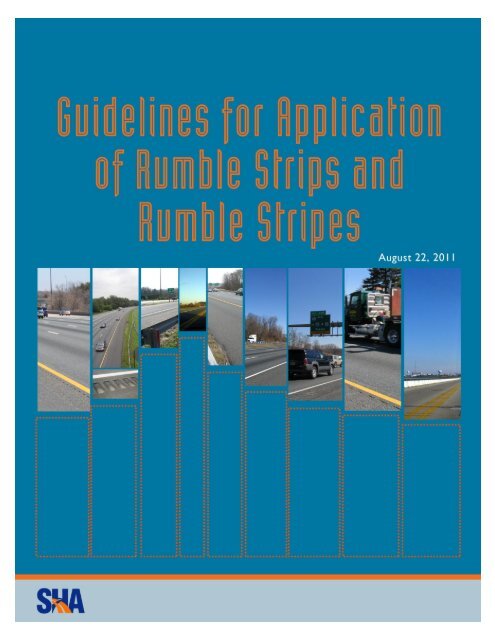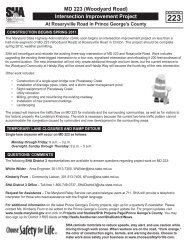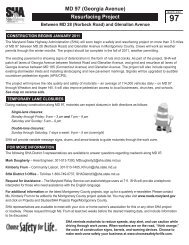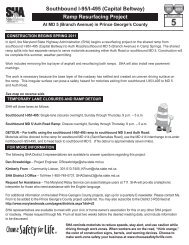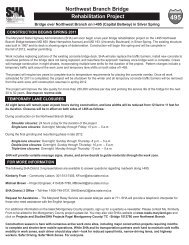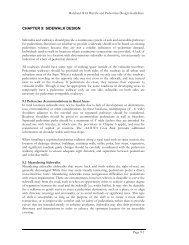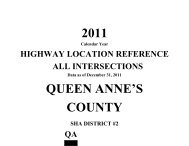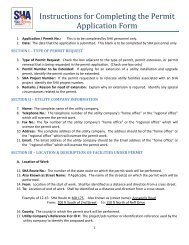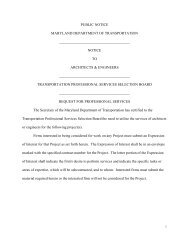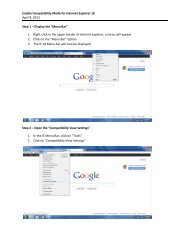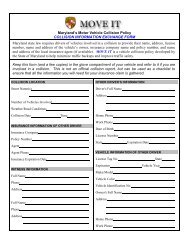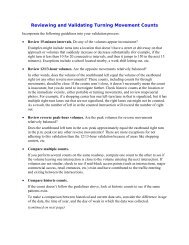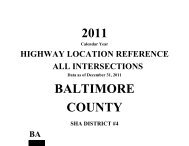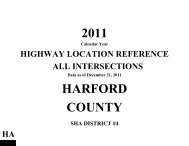Guidelines for Application of Rumble Strips and Rumble Stripes
Guidelines for Application of Rumble Strips and Rumble Stripes
Guidelines for Application of Rumble Strips and Rumble Stripes
Create successful ePaper yourself
Turn your PDF publications into a flip-book with our unique Google optimized e-Paper software.
I. INTRODUCTION<br />
<strong>Guidelines</strong> <strong>for</strong> <strong>Application</strong> <strong>of</strong> <strong>Rumble</strong> <strong>Strips</strong><br />
A. PURPOSE<br />
The intent <strong>of</strong> these guidelines is to establish SHA’s policy on the proper use <strong>and</strong> application <strong>of</strong><br />
longitudinal rumble strips (shoulder <strong>and</strong> centerline), transverse rumble strips, <strong>and</strong> rumble stripes<br />
on Maryl<strong>and</strong>’s highway system. These guidelines replace previous directives <strong>and</strong> guidelines<br />
regarding rumble strips <strong>and</strong> rumble stripes, such as MSHA’s Draft Directive <strong>and</strong> Guidance on<br />
the Use <strong>of</strong> Longitudinal <strong>Rumble</strong> <strong>Strips</strong> (date Revised May 14, 2002), <strong>and</strong> Use <strong>of</strong> Temporary<br />
Transverse <strong>Rumble</strong> <strong>Strips</strong> in Work Zones (SHAs Work Zone Safety Toolbox), <strong>and</strong> consolidates<br />
them with new in<strong>for</strong>mation into a single document.<br />
All future revisions to this document that may impact bicyclists shall require the notification to<br />
both the SHA Bicycle <strong>and</strong> Pedestrian Coordinator within the Office <strong>of</strong> Planning <strong>and</strong> Preliminary<br />
Engineering <strong>and</strong> the MDOT Director <strong>of</strong> Bicycle <strong>and</strong> Pedestrian Access within the Office <strong>of</strong><br />
Planning <strong>and</strong> Capital Programming to gain their input on proposed changes.<br />
B. TARGET USERS<br />
State Highway Administration (SHA) staff/engineers, consultants, <strong>and</strong> local government<br />
agencies.<br />
II. DEFINITIONS<br />
<strong>Rumble</strong> <strong>Strips</strong>: <strong>Rumble</strong> strips are raised or grooved patterns on the roadway or shoulder that<br />
provide audible <strong>and</strong> vibratory warnings to drivers that their vehicles are leaving the driving lane<br />
or are approaching an unusual or unexpected traffic or road condition.<br />
Shoulder <strong>Rumble</strong> <strong>Strips</strong>: Shoulder rumble strips are rumble strips that are placed on or adjacent<br />
to the shoulder to alert drivers that they are leaving the roadway.<br />
Centerline <strong>Rumble</strong> <strong>Strips</strong>: Centerline rumble strips are rumble strips that are placed along the<br />
centerline <strong>of</strong> an undivided highway with pavement markings applied over top <strong>of</strong> the rumble<br />
strips to warn drivers that they are crossing the centerline.<br />
Transverse <strong>Rumble</strong> <strong>Strips</strong>: Transverse rumble strips are rumble strips that extend across the<br />
travel lane to alert drivers to unusual traffic conditions.<br />
Applied <strong>Rumble</strong> <strong>Strips</strong>: Applied rumble strips are rumble strips that are created by placing<br />
pavement marking tape or other product on the roadway surface.<br />
Milled or Ground <strong>Rumble</strong> <strong>Strips</strong>: Milled or ground rumble strips are rumble strips that are<br />
created by milling or grinding depressions into the pavement.<br />
<strong>Rumble</strong> <strong>Stripes</strong>: <strong>Rumble</strong> stripes are rumble strips created by placing edgeline pavement<br />
markings over top <strong>of</strong> rumble strips.<br />
III. POTENTIAL APPLICATIONS<br />
This document provides guidance on where <strong>and</strong> how to install rumble strips <strong>and</strong> rumble stripes.<br />
Except in unusual circumstances as determined by engineering judgment, these devices should<br />
be installed in accordance with this guidance. In addition to the guidelines described herein,<br />
implementation <strong>of</strong> rumble strips should con<strong>for</strong>m to the applicable guidelines in the 2006<br />
MdMUTCD section 6F.84.<br />
A. SHOULDER RUMBLE STRIPS<br />
Shoulder rumble strips may be used along roadways with shoulders to warn motorists that they<br />
are leaving the travel lanes.<br />
1 Issued 01/13/2011 Revised (08/22/2011)
<strong>Guidelines</strong> <strong>for</strong> <strong>Application</strong> <strong>of</strong> <strong>Rumble</strong> <strong>Strips</strong><br />
1. Expressways <strong>and</strong> Controlled-Access Highways<br />
Shoulder rumble strips should be installed along the inside <strong>and</strong> outside shoulders <strong>of</strong> expressways<br />
<strong>and</strong> controlled access highways, with the following exceptions:<br />
An expressway or controlled-access highway having a posted speed limit <strong>of</strong> 40 mph or less.<br />
An expressway or controlled-access highway where an engineering study finds that the<br />
installation <strong>of</strong> shoulder rumble strips is not feasible (e.g., because <strong>of</strong> shoulder width or<br />
condition), the potential safety benefits <strong>of</strong> rumble strips likely cannot be realized, or that<br />
other considerations, such as the use <strong>of</strong> the shoulder by bicyclists, outweigh the potential<br />
safety benefits <strong>of</strong> rumble strips.<br />
The shoulder is designated <strong>for</strong> use by buses or <strong>for</strong> other motor vehicle travel.<br />
As otherwise precluded in these guidelines.<br />
Shoulder rumble strips may be installed along the beltways <strong>and</strong> expressways/controlled-access<br />
highways inside the beltways with written concurrence <strong>of</strong> the District Engineer.<br />
2. Other Highways<br />
Shoulder rumble strips should be installed along the inside <strong>and</strong> outside <strong>of</strong> other divided<br />
highways, <strong>and</strong> along the outside shoulder <strong>of</strong> undivided highways where the posted speed limit is<br />
40 mph or greater, except as otherwise precluded in these guidelines.<br />
Unless an extraordinary circumstance exists, shoulder rumble strips should not be installed along<br />
highways where the posted speed limit is less than 40 mph.<br />
3. Roadways Where Bicycles are Permitted<br />
Along expressways where bicycles are expressly permitted to travel <strong>and</strong> along other highways<br />
where shoulder rumble strips are desirable, the accommodation <strong>of</strong> bicyclists must be considered.<br />
While rumble strips/stripes provide a safe, inexpensive, <strong>and</strong> efficient way to reduce run-<strong>of</strong>f the<br />
road crashes <strong>for</strong> motorists, if used indiscriminately <strong>and</strong>/or improperly they can pose an<br />
impediment to safe bicycle travel. Along highways where bicycles are allowed to travel, care<br />
must be exercised in selecting rumble strips/stripes design <strong>and</strong> placement so as not to create<br />
obstacles <strong>and</strong>/or risks to cyclists. This should include considering the use <strong>of</strong> narrower <strong>and</strong>/or<br />
shallow strips/stripes, as shown in Shoulder <strong>Rumble</strong> Strip <strong>and</strong> <strong>Rumble</strong> Stripe Details (Detail<br />
Sheet 670.05).<br />
The following apply to these highways:<br />
Shoulder Widths<br />
Where the paved outside shoulder is five feet or greater in width, rumble strips are to be<br />
installed in accordance with the typicals shown in Section IV.A. <strong>of</strong> this document.<br />
Where the outside shoulder is less than five feet in width:<br />
- A determination shall be made regarding the actual need <strong>for</strong> rumble strips or stripes<br />
through the specific section based on collision history, horizontal <strong>and</strong> vertical alignment,<br />
etc.<br />
- If it is determined that rumble strips or stripes are desirable, rumble stripes shall be used<br />
whenever possible to retain as much shoulder width as possible.<br />
- If, due to motorized traffic conditions, the use <strong>of</strong> rumble strips is the only treatment that<br />
will be effective, the Lead Project Manager shall make a <strong>for</strong>mal Design Waiver request to<br />
use them, as described in the Policy <strong>and</strong> Design Waiver Process <strong>for</strong> Bicycle<br />
Accommodations along State Highways, to the Director <strong>of</strong> the Office <strong>of</strong> Highway<br />
Development.<br />
Roadway corridors with segments that have deficient shoulder widths should not preclude the<br />
use <strong>of</strong> shoulder rumble strips <strong>for</strong> the entire corridor. Deficient shoulders are defined as<br />
shoulders where the lateral distance from the outside edge <strong>of</strong> the rumble strip to the outside<br />
2 Issued 01/13/2011 Revised (08/22/2011)
<strong>Guidelines</strong> <strong>for</strong> <strong>Application</strong> <strong>of</strong> <strong>Rumble</strong> <strong>Strips</strong><br />
edge <strong>of</strong> the shoulder is less than 4 feet or to the face <strong>of</strong> traffic barrier is less than 5 feet. In<br />
these segments rumble strips should not be installed <strong>for</strong> the length that the deficient shoulder<br />
exists. In determining the minimum clear width, consideration should be given to decreasing<br />
the width <strong>of</strong> the rumble strips <strong>and</strong>/or placing them closer to the roadway edge, <strong>and</strong> the use <strong>of</strong><br />
rumble stripes.<br />
Shoulder widths should be based on actual field measurements <strong>and</strong> not on reliance <strong>of</strong> widths<br />
shown on plans, as-builts, or inventories.<br />
Gaps<br />
Gaps <strong>for</strong> bicyclists are not to be provided along highways where the posted speed limit is 55<br />
mph or greater, except at intersections <strong>and</strong>/or at other locations as noted in this guideline.<br />
Although safety is maximized by continuous rumble strips, <strong>for</strong> highways where the posted<br />
speed limit is less than 55 mph, gaps <strong>for</strong> bicyclists shall be installed.<br />
Gaps, except at approaches to intersections, should be installed with a 60-foot pattern (12foot<br />
gap following a 48-foot length <strong>of</strong> rumble strips). This pattern can be adjusted to<br />
accommodate specific milling equipment or <strong>for</strong> other sound reasons; however, the gap<br />
should not be less than 8 feet nor greater than 12 feet <strong>and</strong> gaps should not be spaced less than<br />
36 feet or more than 60 feet apart.<br />
Gaps shall be provided on all roadways with rumble strips at all intersections (i.e. 3-legged,<br />
4-legged, etc.) regardless <strong>of</strong> posted speed.<br />
- For lower speed roadways (less than or equal to 40 mph) gaps shall start 25 feet in<br />
advance <strong>of</strong> the point <strong>of</strong> curvature <strong>of</strong> intersections or at the beginning <strong>of</strong> the taper <strong>for</strong> the<br />
left/right-turn lane(s), <strong>and</strong> stop 25 feet beyond the intersection.<br />
- For higher speed roadways (greater than 40 mph) gaps shall start 50 feet in advance <strong>of</strong><br />
the point <strong>of</strong> curvature <strong>of</strong> intersections or at the beginning <strong>of</strong> the taper <strong>for</strong> the left/rightturn<br />
lane(s), <strong>and</strong> stop 50 feet beyond the intersection.<br />
- Providing gaps at all intersections allows bicyclists to make turns onto side streets from<br />
mainline roadways with rumble strips with no gaps (due to their posted speed).<br />
- In addition, providing gaps at all intersections allows bicyclists from side streets to enter<br />
mainline roadways with rumble strips with no gaps (due to their posted speed).<br />
- All gap spacing shall con<strong>for</strong>m to the requirements below.<br />
Additional Guidance <strong>and</strong> Consideration<br />
Noise from rumble strip hits should be considered when determining whether to install<br />
rumble strips or rumble stripes near residential areas or other sensitive receptors. This should<br />
be a secondary consideration to safety.<br />
<strong>Rumble</strong> strips or rumble stripes should not be installed where the surface condition is<br />
inadequate <strong>for</strong> their installation or, except <strong>for</strong> unusual circumstances, where resurfacing or<br />
other work that would substantially decrease the effectiveness <strong>of</strong> the strips is anticipated<br />
within the next two years. The Assistant District Engineers <strong>for</strong> Maintenance, Traffic <strong>and</strong><br />
Construction shall evaluate roadway pavement condition when planning <strong>and</strong> programming<br />
projects <strong>for</strong> rumble strip application.<br />
Consideration should be given to selecting the shallower depth rumble strips from the range<br />
provided in Shoulder <strong>Rumble</strong> Strip <strong>and</strong> <strong>Rumble</strong> Stripe Details (Detail Sheet 670.05). The<br />
shallower depth rumble strips provide benefits to bicyclists while still maintaining the<br />
audible <strong>and</strong> vibratory warning to motorists.<br />
<strong>Rumble</strong> stripes may be installed in lieu <strong>of</strong> shoulder rumble strips with the concurrence <strong>of</strong> the<br />
District Engineer. See Section III.E. <strong>for</strong> further discussion <strong>of</strong> <strong>Rumble</strong> <strong>Stripes</strong>.<br />
More experienced bicyclists have expressed desire to ride between the edgeline <strong>and</strong> the<br />
rumble strip to avoid debris that commonly collects along the shoulders to the right <strong>of</strong> the<br />
3 Issued 01/13/2011 Revised (08/22/2011)
<strong>Guidelines</strong> <strong>for</strong> <strong>Application</strong> <strong>of</strong> <strong>Rumble</strong> <strong>Strips</strong><br />
rumble strip. Keeping the shoulders reasonably free from debris through periodic brooming<br />
<strong>and</strong> by the prompt removal <strong>of</strong> disabled vehicles (within the limits <strong>of</strong> Maryl<strong>and</strong> law) will<br />
encourage bicyclists to ride to the right <strong>of</strong> the rumble strip.<br />
B. CENTERLINE RUMBLE STRIPS<br />
Centerline rumble strips should be installed along an undivided highway with a 40 mph or<br />
greater posted speed limit <strong>and</strong> 10 foot or greater lane widths in a generally rural area unless,<br />
based on engineering judgment, it has been determined that their installation would not improve<br />
safety.<br />
Centerline rumble strips should NOT be installed:<br />
In the area <strong>of</strong> intersections with public roads. Centerline rumble strips should be stopped 25<br />
to 50 feet (25 feet <strong>for</strong> lower speed roadways <strong>and</strong> up to 50 feet <strong>for</strong> higher speed roadways) in<br />
advance <strong>of</strong> the point <strong>of</strong> curvature <strong>of</strong> intersections or at the beginning <strong>of</strong> the taper <strong>for</strong> the leftturn<br />
lane.<br />
In areas with a high density <strong>of</strong> access points or in areas with short distances between access<br />
points.<br />
Additional Guidance <strong>and</strong> Consideration<br />
Centerline rumble strips may be installed in passing zones; however, the noise impacts to<br />
residential areas nearby should be considered.<br />
Consideration must be given to bicycle travel <strong>and</strong> the potential impact <strong>of</strong> reducing the clear<br />
lane width where bicycles ride in the roadway.<br />
C. Transverse rumble strips<br />
Transverse rumble strips may be used to attract the driver’s attention to unexpected conditions or<br />
to bring the driver’s attention to other warning devices. Transverse rumble strips may be<br />
considered <strong>for</strong> the following conditions:<br />
1. Approaches to Intersections (Signalized, Stop Controlled, Roundabouts)<br />
Transverse rumble strips should be considered on the approaches to intersections where there is a<br />
demonstrated safety problem (e.g. high crash rate), adequate trial <strong>of</strong> other warning devices has<br />
failed to reduce the crash frequency, <strong>and</strong> any <strong>of</strong> the following conditions exist:<br />
Inadequate stopping sight distance or signal/sign visibility.<br />
Intersection is at an unexpected location.<br />
Intersection is located on a roadway on which motorists have not been required to stop <strong>for</strong> a<br />
long period <strong>of</strong> time or distance.<br />
2. Approaches to Horizontal Curves<br />
Transverse rumble strips should be considered on the approaches to horizontal curves where<br />
there is a demonstrated safety problem (e.g. high crash rate), adequate trial <strong>of</strong> other warning<br />
devices has failed to reduce the crash frequency, <strong>and</strong> any <strong>of</strong> the following conditions exist:<br />
A significant speed reduction from the posted speed limit is required to safely traverse the<br />
curve.<br />
Curve is located at an unexpected location.<br />
3. Approaches to Reduced Speed Zones<br />
Transverse rumble strips should be considered on the approaches to reduced speed zones where<br />
an engineering study finds that excessive speeding is a problem in a reduced speed zone <strong>and</strong><br />
adequate trial <strong>of</strong> other regulatory devices has failed to reduce the occurrence <strong>of</strong> speeding. Factors<br />
that may indicate a need include:<br />
Posted speed reduction <strong>of</strong> 20 mph or greater.<br />
4 Issued 01/13/2011 Revised (08/22/2011)
<strong>Guidelines</strong> <strong>for</strong> <strong>Application</strong> <strong>of</strong> <strong>Rumble</strong> <strong>Strips</strong><br />
Entrance to a town, business district, or location where significant pedestrian activity is<br />
anticipated.<br />
The character <strong>of</strong> the roadway changes, such as at the end <strong>of</strong> a freeway.<br />
4. Approaches to Toll Plazas<br />
Transverse rumble strips should be considered on the approaches to Toll Plazas where motorists<br />
are required to stop or slow to pay a toll.<br />
5. Approaches to Work Zones<br />
Transverse rumble strips may be used in work zones in advance <strong>of</strong> detours, flaggers, lane splits,<br />
crossovers, lane transitions, exit only lanes, lane closures, temporary traffic signals, <strong>and</strong> locations<br />
with major reductions in speed limits. Transverse rumble strips are not generally used <strong>for</strong> shortterm<br />
maintenance related construction. When installed on a temporary basis, rumble strips<br />
should be sufficiently durable to cover the period <strong>of</strong> need. When temporary rumble strips are no<br />
longer needed, they should be removed from the pavement <strong>and</strong> the pavement should be cleaned<br />
<strong>and</strong> restored to normal conditions.<br />
Additional Guidance <strong>and</strong> Consideration<br />
Other less invasive measures should be tried be<strong>for</strong>e transverse rumble strips are<br />
recommended.<br />
Transverse rumble strips should not be placed on roadways where bicycles are permitted<br />
unless a minimum clear path <strong>of</strong> 4 feet is provided at each edge <strong>of</strong> the roadway or each paved<br />
shoulder as described in AASHTO’s Guide to the Development <strong>of</strong> Bicycle Facilities.<br />
Transverse rumble strips may be supplemented with additional pavement marking warning<br />
messages such as ―STOP AHEAD‖ or ―SIGNAL AHEAD‖ where the purpose <strong>of</strong> the rumble<br />
strips may not be clear.<br />
The use <strong>of</strong> transverse rumble strips near residential areas or other sensitive noise receptors<br />
should be carefully evaluated.<br />
Transverse rumble strips should not be placed on sharp horizontal or vertical curves.<br />
The use <strong>of</strong> transverse rumble strips in shoulders to deter motorists from traveling in the<br />
shoulder <strong>for</strong> long distances where there is specific justification <strong>for</strong> their installation requires<br />
the written concurrence <strong>of</strong> the Director, Office <strong>of</strong> Traffic <strong>and</strong> Safety <strong>and</strong> the Director, Office<br />
<strong>of</strong> Maintenance. Transverse rumble strips should not be installed in shoulders where bicycle<br />
activity is anticipated.<br />
D. RUMBLE STRIPS BETWEEN LANES<br />
With specific justification <strong>and</strong> the concurrence <strong>of</strong> the Director, Office <strong>of</strong> Traffic <strong>and</strong> Safety <strong>and</strong><br />
the Director, Office <strong>of</strong> Maintenance, rumble strips may be installed between adjacent lanes<br />
moving in the same direction at the following locations:<br />
Where there is a need to further discourage prohibited lane changing.<br />
Between the through lanes <strong>and</strong> collector/distributor lanes where there is no physical barrier.<br />
E. RUMBLE STRIPES<br />
For any roadway with a 40 mph or greater posted speed limit <strong>and</strong> 11 foot or greater lane widths,<br />
rumble stripes may be installed where due to the lack <strong>of</strong> shoulders or adequate shoulder width,<br />
shoulder rumble strip installation is not feasible.<br />
At the discretion <strong>of</strong> the District Engineer, rumble stripes may be installed in lieu <strong>of</strong> shoulder<br />
rumble strips on any roadway, regardless <strong>of</strong> the presence <strong>of</strong> adequate shoulders.<br />
Along roadways where bicycles are expressly permitted to travel <strong>and</strong> along other highways<br />
where shoulder rumble stripes are installed, the accommodation <strong>of</strong> bicyclists must be considered.<br />
5 Issued 01/13/2011 Revised (08/22/2011)
<strong>Guidelines</strong> <strong>for</strong> <strong>Application</strong> <strong>of</strong> <strong>Rumble</strong> <strong>Strips</strong><br />
The conditions set <strong>for</strong>th in Section III.A.3. regarding gaps <strong>and</strong> additional considerations shall<br />
apply.<br />
IV. DESIGN GUIDELINES<br />
The following guidelines apply to the design <strong>and</strong> installation <strong>of</strong> all rumble strips <strong>and</strong> rumble<br />
stripes:<br />
Milled or ground rumble strips <strong>and</strong> rumble stripes are not to be installed on Portl<strong>and</strong> Cement<br />
Concrete bridge decks or on Portl<strong>and</strong> Cement Concrete bridge approach slabs.<br />
Milled or ground rumble strips <strong>and</strong> rumble stripes can be used on new or existing pavement.<br />
To retr<strong>of</strong>it rumble strips <strong>and</strong> rumble stripes on existing pavement, the pavement should be in<br />
sufficiently good condition to effectively accept the milling process without raveling or<br />
deteriorating. Otherwise the pavement should be upgraded prior to milling any desired<br />
rumble strips <strong>and</strong> rumble stripes. The Assistant District Engineers <strong>for</strong> Maintenance, Traffic<br />
<strong>and</strong> Construction shall evaluate roadway pavement condition when planning <strong>and</strong><br />
programming projects <strong>for</strong> rumble strip <strong>and</strong> rumble stripe application.<br />
To the extent practicable, rumble strips <strong>and</strong> rumble stripes should avoid in-surface vehicle<br />
detectors <strong>and</strong> their leads, other highway wiring, raised pavement markers (RPMs), other<br />
traffic control devices, <strong>and</strong> other highway appurtances.<br />
A. SHOULDER RUMBLE STRIPS<br />
Shoulder rumble strips are to be milled or ground into the pavement surface. With the<br />
concurrence <strong>of</strong> the Director, Office <strong>of</strong> Traffic <strong>and</strong> Safety <strong>and</strong> the Director, Office <strong>of</strong><br />
Maintenance, applied shoulder rumble strips may be used on an experimental basis.<br />
Where it is determined that gaps in shoulder rumble strips are required to accommodate bicycles<br />
(see Section III.3.), gap spacing should be installed as shown in Figure 1. Gaps in rumble stripes<br />
should be considered where appropriate or necessary to accommodate bicycles (i.e. areas with<br />
shoulders less than 4’ in width being used by bicyclists), gap spacing should be installed as<br />
shown in Figure 1.<br />
Figure 1 – Gap Spacing <strong>for</strong> Shoulder <strong>Rumble</strong> <strong>Strips</strong> <strong>and</strong><br />
<strong>Rumble</strong> <strong>Stripes</strong> to Accommodate Bicyclists<br />
In roadway segments with deficient shoulder widths (defined as shoulders where the lateral<br />
distance from the outside edge <strong>of</strong> the rumble strip to the outside edge <strong>of</strong> the shoulder is less than<br />
4 feet or to the face <strong>of</strong> traffic barrier is less than 5 feet) rumble strips should not be installed <strong>for</strong><br />
the length that the deficient shoulder exists as shown in Figure 2.<br />
6 Issued 01/13/2011 Revised (08/22/2011)
<strong>Guidelines</strong> <strong>for</strong> <strong>Application</strong> <strong>of</strong> <strong>Rumble</strong> <strong>Strips</strong><br />
Figure 2 – Shoulder <strong>Rumble</strong> <strong>Strips</strong> In Areas with Deficient Shoulder Widths<br />
B. CENTERLINE RUMBLE STRIPS<br />
Centerline rumble strips are to be milled or ground into the pavement surface with pavement<br />
marking material applied over top. With the concurrence <strong>of</strong> the Director, Office <strong>of</strong> Traffic <strong>and</strong><br />
Safety <strong>and</strong> the Director, Office <strong>of</strong> Maintenance, applied centerline rumble strips may be used on<br />
an experimental basis.<br />
Installation <strong>of</strong> centerline rumble strips should be coordinated with permanent pavement marking<br />
<strong>and</strong> RPM placement. Permanent pavement markings <strong>and</strong> RPMs should be installed after<br />
installation <strong>of</strong> the rumble strips is complete. Liquid applied pavement marking materials such as,<br />
thermoplastic or paint shall be used <strong>for</strong> centerline markings in conjunction with centerline<br />
rumble strips.<br />
Centerline rumble strips should be spaced along the centerline <strong>of</strong> a roadway as shown in<br />
Centerline <strong>Rumble</strong> Strip Details <strong>and</strong> Typical Layout (Detail Sheet 670.06). Installation <strong>of</strong> raised<br />
pavement markers (RPMs) with centerline rumble strips is optional, as shown in Centerline<br />
<strong>Rumble</strong> Strip Details <strong>and</strong> Typical Layout (Detail Sheet 670.06).<br />
Centerline rumble strips should be stopped 25 to 50 feet in advance <strong>of</strong> the point <strong>of</strong> curvature <strong>of</strong><br />
intersections or at the beginning <strong>of</strong> the taper <strong>for</strong> the left-turn lane (25 feet <strong>for</strong> roadways with<br />
posted speed limits less than or equal to 45 MPH, <strong>and</strong> up to 50 feet <strong>for</strong> roadways with posted<br />
speed limits greater than 45 MPH).<br />
C. TRANSVERSE RUMBLE STRIPS<br />
Transverse rumble strips are to be applied to the pavement surface with pavement marking<br />
material. Milled or ground transverse rumble strips may be used with the concurrence <strong>of</strong> the<br />
Director, Office <strong>of</strong> Traffic <strong>and</strong> Safety <strong>and</strong> the Director, Office <strong>of</strong> Maintenance. The guidelines<br />
described herein are applicable to applied transverse rumble strips.<br />
Applied transverse rumble strips are created by placing two pieces <strong>of</strong> pre<strong>for</strong>med pavement<br />
marking material on top <strong>of</strong> each other to obtain the desired thickness. Options include:<br />
Placing a 10‖ pavement marking strip on the pavement <strong>and</strong> then a 5‖ pavement marking strip<br />
on top <strong>of</strong> the 10‖ pavement marking strip.<br />
Placing two 5‖ pavement marking strips on the pavement applied on top <strong>of</strong> each other (more<br />
aggressive application).<br />
Figure 3 shows an example <strong>of</strong> the recommended placement <strong>of</strong> applied transverse rumble strips<br />
on the approach to a "Stop Ahead" sign. The "STOP AHEAD" pavement markings <strong>and</strong> the two<br />
7 Issued 01/13/2011 Revised (08/22/2011)
<strong>Guidelines</strong> <strong>for</strong> <strong>Application</strong> <strong>of</strong> <strong>Rumble</strong> <strong>Strips</strong><br />
sets <strong>of</strong> rumble strips located after the "Stop Ahead" sign are optional. This same application<br />
could be used prior to other warning signs including "Signal Ahead", "Yield Ahead",<br />
"Roundabout Ahead", "Reduced Speed Ahead", <strong>and</strong> other traffic control devices.<br />
Figure 3 –Transverse <strong>Rumble</strong> Strip Placement<br />
D. RUMBLE STRIPS BETWEEN LANES<br />
The specific design (width, spacing, lateral placement, etc.) <strong>of</strong> rumble strips to be installed<br />
between lanes should be selected based on the identified problems <strong>and</strong> specific traffic, roadway,<br />
<strong>and</strong> area conditions; <strong>and</strong> approved by the Director, Office <strong>of</strong> Traffic <strong>and</strong> Safety.<br />
E. RUMBLE STRIPES<br />
<strong>Rumble</strong> stripes are to be milled or ground into the pavement surface with pavement marking<br />
material applied over top.<br />
Installation <strong>of</strong> rumble stripes should be coordinated with permanent pavement marking <strong>and</strong> RPM<br />
placement. Permanent pavement markings <strong>and</strong> RPMs shall be installed after installation <strong>of</strong> the<br />
rumble strips is complete. Typically thermoplastic or paint materials shall be used <strong>for</strong> rumble<br />
stripe markings. Pre<strong>for</strong>med tape materials shall not be used <strong>for</strong> rumble stripe application.<br />
<strong>Rumble</strong> stripes should be stopped 25 to 50 feet in advance <strong>of</strong> the point <strong>of</strong> curvature <strong>of</strong><br />
intersections or at the beginning <strong>of</strong> the taper <strong>for</strong> the left-turn lane (25 feet <strong>for</strong> roadways with<br />
posted speed limits less than or equal to 45 MPH, <strong>and</strong> up to 50 feet <strong>for</strong> roadways with posted<br />
speed limits greater than 45 MPH).<br />
One <strong>of</strong> the key considerations <strong>for</strong> the installation <strong>of</strong> rumble stripes is maintaining a minimum<br />
effective lane width. Effective lane width is defined as the clear distance between a pavement<br />
marking or centerline rumble strip on the left side <strong>of</strong> the travel lane <strong>and</strong> the rumble strip<br />
associated with the rumble stripe on the right side <strong>of</strong> the travel lane. The minimum effective lane<br />
width that should be maintained is 9’- 4‖. This is calculated assuming a minimum travel lane<br />
8 Issued 01/13/2011 Revised (08/22/2011)
<strong>Guidelines</strong> <strong>for</strong> <strong>Application</strong> <strong>of</strong> <strong>Rumble</strong> <strong>Strips</strong><br />
width (measured from the roadway centerline to the pavement joint/edge) <strong>of</strong> 11’ <strong>and</strong> subtracting<br />
8‖ <strong>for</strong> half the width <strong>of</strong> centerline rumble strips, 6‖ <strong>for</strong> the minimum <strong>of</strong>fset <strong>for</strong> rumble strips<br />
from the pavement joint/edge, <strong>and</strong> 6‖ <strong>for</strong> the rumble strip/stripe width.<br />
Another consideration <strong>for</strong> the installation <strong>of</strong> rumble stripes is maintaining the existing shoulder<br />
width <strong>for</strong> bicycle use, regardless <strong>of</strong> whether the width meets 48‖ minimum required by current<br />
st<strong>and</strong>ards. The intent is not to remove the current usable bicycle area in order to install rumble<br />
stripes. For roadways with no shoulders consideration should be given to bicycle<br />
accommodations with rumble stripes. See Section III.A.3. <strong>for</strong> further guidance.<br />
F. DETAILS<br />
Shoulder rumble strips, centerline rumble strips, transverse rumble strips, rumble strips between<br />
lanes, <strong>and</strong> rumble stripes are to be installed in accordance with the following details. These<br />
details, in some cases modify existing st<strong>and</strong>ard details. See the chart below <strong>for</strong> more in<strong>for</strong>mation.<br />
Current<br />
Std. No.<br />
New Detail<br />
No.<br />
670.00 670.00<br />
670.01 n/a n/a<br />
670.02 670.01<br />
n/a 670.02<br />
n/a 670.03<br />
n/a 670.04<br />
n/a 670.05<br />
n/a 670.06<br />
New Detail Title Remarks<br />
LOCATION OF SHOULDER RUMBLE<br />
STRIPS<br />
LOCATION OF SHOULDER RUMBLE<br />
STRIPS AT CRITICAL LOCATIONS<br />
RIGHT SIDE SHOULDER RUMBLE STRIP<br />
DETAILS TYPICAL LAYOUT<br />
LEFT SIDE SHOULDER RUMBLE STRIP<br />
DETAILS TYPICAL LAYOUT<br />
RUMBLE STRIPE DETAILS TYPICAL<br />
LAYOUT<br />
SHOULDER RUMBLE STRIP AND<br />
RUMBLE STRIPE DETAILS<br />
CENTERLINE RUMBLE STRIP DETAILS<br />
AND TYPICAL LAYOUT<br />
Revisions to<br />
current st<strong>and</strong>ard<br />
St<strong>and</strong>ard to be<br />
deleted<br />
Revisions to<br />
current st<strong>and</strong>ard<br />
New detail<br />
New detail<br />
New detail<br />
New detail<br />
New detail<br />
9 Issued 01/13/2011 Revised (08/22/2011)
10 Issued 01/13/2011 Revised (08/22/2011)
11 Issued 01/13/2011 Revised (08/22/2011)
12 Issued 01/13/2011 Revised (08/22/2011)
13 Issued 01/13/2011 Revised (08/22/2011)
14 Issued 01/13/2011 Revised (08/22/2011)
15 Issued 01/13/2011 Revised (08/22/2011)
<strong>Guidelines</strong> <strong>for</strong> <strong>Application</strong> <strong>of</strong> <strong>Rumble</strong> <strong>Strips</strong><br />
SPECIAL PROVISIONS<br />
APPENDIX<br />
For Shoulder <strong>Rumble</strong> <strong>Strips</strong> – refer to Section 610 in Maryl<strong>and</strong> State Highway<br />
Administration's St<strong>and</strong>ard Specifications <strong>for</strong> Construction <strong>and</strong> Materials.<br />
For Centerline, Between Lane, <strong>and</strong> Edgeline <strong>Rumble</strong> <strong>Strips</strong> <strong>and</strong> <strong>Rumble</strong> <strong>Stripes</strong> – a copy<br />
<strong>of</strong> the latest Special Provision is provided <strong>for</strong> reference purposes only. Refer to the latest<br />
Special Provision from Maryl<strong>and</strong> State Highway Administration's Office <strong>of</strong> Highway<br />
Development.<br />
For Transverse <strong>Rumble</strong> <strong>Strips</strong> – a copy <strong>of</strong> the latest Special Provision is provided <strong>for</strong><br />
reference purposes only. Refer to the latest Special Provision from Maryl<strong>and</strong> State<br />
Highway Administration's Office <strong>of</strong> Highway Development.<br />
16 Issued 01/13/2011 Revised (08/22/2011)
SPECIAL PROVISION CONTRACT NO. ContNum<br />
500 — CENTERLINE, BETWEEN LANE, AND EDGELINE RUMBLE STRIPS AND<br />
RUMBLE STRIPES 1 <strong>of</strong> 1<br />
CATEGORY 500<br />
PAVING<br />
CENTERLINE, BETWEEN LANE, AND EDGELINE<br />
RUMBLE STRIPS AND RUMBLE STRIPES<br />
DESCRIPTION. Mill or grind rumble strips into existing hot mix asphalt or portl<strong>and</strong><br />
cement concrete roadways on the centerline strip, the between lanes, or at the edgeline at the<br />
specified locations. <strong>Rumble</strong> strips designated as <strong>Rumble</strong> <strong>Stripes</strong> will have pavement<br />
marking applied over the rumble strip<br />
MATERIALS. Not Applicable.<br />
CONSTRUCTION. Install rumble strips as specified or as directed.<br />
Mill or grind centerline, between lane <strong>and</strong> edge line rumble strips into hot mix asphalt at<br />
a minimum rate <strong>of</strong> 4000 strips per hour, <strong>and</strong> into portl<strong>and</strong> cement concrete at a minimum rate<br />
<strong>of</strong> 1000 strips per hour.<br />
<strong>Rumble</strong> <strong>Stripes</strong> will have the pavement marking applied after the rumble strips are milled.<br />
Equipment. Provide rotary type cutting heads with a maximum outside diameter <strong>of</strong> 24 in.<br />
<strong>and</strong> a length <strong>of</strong> 16 in. The cutting heads shall have the cutting tips arranged in a pattern<br />
providing a relatively smooth cut, approximately 1/16 in. between peaks <strong>and</strong> valleys.<br />
Provide cutting heads mounted on their own suspension, independent <strong>of</strong> the power unit, to<br />
allow the tool to self-align with the slope <strong>of</strong> the roadway <strong>and</strong> any irregularities in the<br />
roadway surface.<br />
Provide cutting tools equipped with guides that provide consistent alignment <strong>of</strong> each cut<br />
in relation to the roadway, <strong>and</strong> provide uni<strong>for</strong>mity throughout the project. The Engineer will<br />
r<strong>and</strong>omly check the pattern edge alignment.<br />
Control Strip. Mill or grind a minimum 100 ft control strip to demonstrate that the speed <strong>of</strong><br />
operation, dimensions, <strong>and</strong> texture are acceptable.<br />
Clean up. Clean pavement by sweeping or vacuuming the work area be<strong>for</strong>e the roadway is<br />
reopened to traffic. Remove all waste material resulting from the operation from the site, <strong>and</strong><br />
disposed <strong>of</strong> it in an approved manner. Do not sweep the material to the side <strong>of</strong> the road.<br />
MEASUREMENT AND PAYMENT. Centerline, Between Lane <strong>and</strong> Edgeline <strong>Rumble</strong><br />
<strong>Strips</strong> in hot mix asphalt or portl<strong>and</strong> cement concrete will be measured <strong>and</strong> paid <strong>for</strong> a the<br />
Contract unit price per linear foot as measured along the centerline where the rumble strips<br />
are actually placed. Payment will be full compensation <strong>for</strong> milling or grinding <strong>of</strong> rumble<br />
strips, cleaning <strong>and</strong> disposal <strong>of</strong> waste material, control strip installation, <strong>and</strong> <strong>for</strong> all material,<br />
labor, equipment, tools, <strong>and</strong> incidentals necessary to complete the work.<br />
Pavement Marking Material <strong>for</strong> <strong>Rumble</strong> <strong>Stripes</strong> will be paid <strong>for</strong> as specified in the pavement<br />
marking item.<br />
06-28-11
SPECIAL PROVISION CONTRACT NO. ContNum<br />
500 —RUMBLE STRIPES 1 <strong>of</strong> 1<br />
CATEGORY 500<br />
PAVING<br />
TRANSVERSE RUMBLE STRIPS<br />
DESCRIPTION. Furnish <strong>and</strong> install heat applied pre<strong>for</strong>med thermoplastic pavement<br />
marking lines to various surfaces to create transverse rumble strips as specified or as<br />
directed.<br />
MATERIALS. Pre<strong>for</strong>med Thermoplastic is a durable pavement marking material. Select<br />
all Pre<strong>for</strong>med Thermoplastic Pavement Marking material shall be selected from the Qualified<br />
Products List.<br />
Heat Applied Permanent Pre<strong>for</strong>med<br />
Thermoplastic Pavement Marking Material 951.06<br />
CONSTRUCTION. Refer to Section 556.<br />
Cleaning Pavement Surfaces. Refer to 549.03.02.<br />
Form Transverse <strong>Rumble</strong> <strong>Strips</strong> by placing two pieces or more <strong>of</strong> pavement marking<br />
material on top <strong>of</strong> each other to obtain the desired thickness as specified or as directed.<br />
MEASUREMENT AND PAYMENT. Transverse <strong>Rumble</strong> <strong>Strips</strong> will be measured <strong>and</strong><br />
paid <strong>for</strong> the actual length installed multiplied by the number <strong>of</strong> layers required to <strong>for</strong>m each<br />
rumble strip within a set <strong>of</strong> rumble strips. Payment will be full compensation <strong>for</strong> all<br />
pavement preparation, color <strong>and</strong> width specified, markings, testing, <strong>and</strong> <strong>for</strong> all material,<br />
labor, equipment, tools, <strong>and</strong> incidentals necessary to complete the work.<br />
04-05-11


